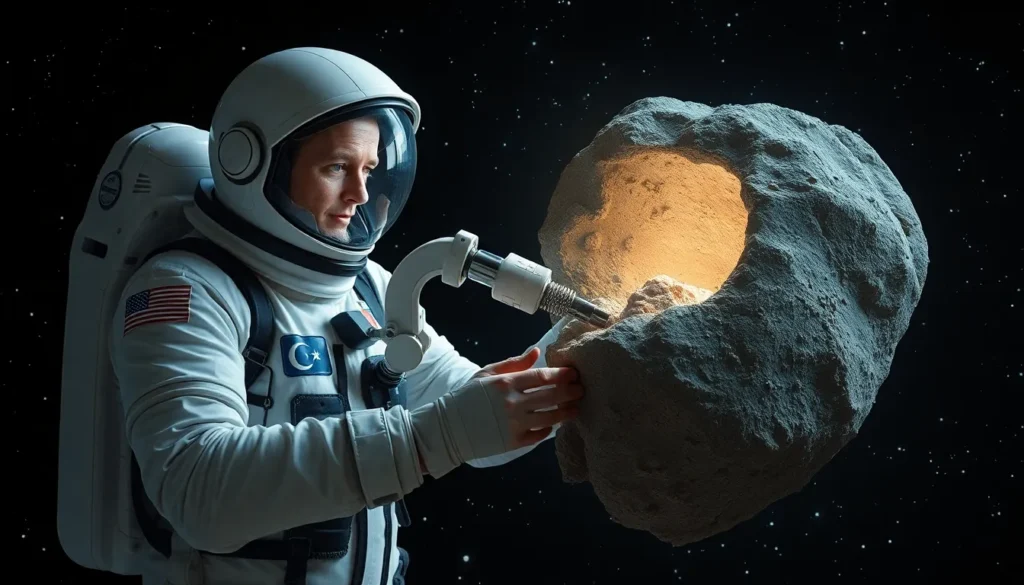Table of Contents
ToggleAs humanity’s gaze turns to the stars, the concept of space mining is quickly shifting from science fiction to reality. With Earth’s resources dwindling, the potential for extracting valuable minerals and materials from asteroids and other celestial bodies has captured the imagination of scientists and entrepreneurs alike. This burgeoning field promises not only to revolutionize resource acquisition but also to pave the way for sustainable space exploration.
Innovations in space mining technology are at the forefront of this cosmic gold rush. From advanced robotics to autonomous spacecraft, these developments aim to unlock the vast wealth of materials floating in our solar system. As companies and governments invest in research and development, the future of space mining holds both exciting possibilities and significant challenges that could reshape our understanding of resource management on Earth and beyond.
Overview of Space Mining Technology
Space mining technology focuses on the extraction of valuable resources from celestial bodies, aiming to harness minerals and materials beyond Earth. This sector has witnessed significant advancements, driven primarily by innovations in engineering, robotics, and aerospace technologies.
Key Technologies in Space Mining
- Asteroid Prospecting: The use of spacecraft equipped with sensors and imaging systems identifies resource-rich asteroids. These systems analyze surfaces to locate metals such as nickel, cobalt, and precious metals like gold and platinum.
- Robotic Miners: Autonomous robots conduct extraction operations in harsh space environments. These robots, capable of handling challenging terrain, utilize drilling and processing techniques to gather resources efficiently.
- In-Situ Resource Utilization (ISRU): ISRU techniques facilitate the processing of materials found on celestial bodies. This technology converts local materials into fuel or essential elements for construction, reducing reliance on Earth-based supplies.
- Mining Equipment Design: Innovative designs focus on lightweight and durable construction for tools and machinery. Adaptations to perform in microgravity conditions improve efficiency and feasibility of mining operations.
Challenges in Space Mining
- Technical Constraints: Developing reliable technology for long-duration space missions poses numerous challenges. The harsh environment demands robust systems capable of functioning in extreme temperatures and radiation levels.
- Economic Viability: Financial investments in space mining are substantial. Economic models must demonstrate profitability, balancing the costs of extraction, transport, and processing against potential market values of the harvested materials.
- Legal and Ethical Issues: The Outer Space Treaty, established in 1967, complicates ownership and utilization rights of resources in space. Addressing these legal frameworks is critical for future operations.
- Environmental Concerns: Mining activities could disrupt the natural state of celestial bodies. Identifying sustainable practices while minimizing ecological impact remains essential.
Future Directions in Space Mining Technology
- Collaboration with Private Sector: Partnerships between government agencies and private companies enhance technological development and investment in space mining ventures. Collaborations may accelerate innovation and lower operational costs.
- Advancements in AI: Artificial intelligence enhances mining operations by enabling robots to make autonomous decisions. AI can optimize resource extraction processes and adapt to unpredictable conditions in space environments.
- Expansion to Other Celestial Bodies: Research is ongoing regarding mining operations on the Moon and Mars. These locations offer diverse resources; lunar regolith contains helium-3, while Martian soil may provide essential minerals for future colonization efforts.
Space mining technology represents a critical evolution in resource acquisition, promising significant implications for both Earth and the broader solar system.
Current Technologies in Space Mining

Space mining technologies continue to evolve, enabling efficient resource extraction from celestial bodies. Two primary focuses are asteroid mining techniques and lunar mining methods.
Asteroid Mining Techniques
Asteroid mining employs various advanced techniques designed for prospecting and extraction.
- Prospecting with Sensors: Advanced sensors detect the composition of asteroids, identifying valuable materials such as platinum group metals and water. Spectrometers onboard spacecraft analyze surface compositions quickly and accurately.
- Robotic Miners: Autonomous robotic miners operate in microgravity environments, extracting materials with precision. These miners utilize tools like drills and scoops, employing artificial intelligence for autonomous decision-making in real-time.
- Orbital Processing: Some concepts suggest processing extracted materials in orbit to minimize transport costs back to Earth. Resource utilization includes transforming materials into fuel or building components for spacecraft.
- Extraction Methods: Techniques such as thermal mining use heat to extract volatile compounds; impact mining uses projectiles to produce fragments that can be captured and processed. Each method adapts to the unique conditions of specific asteroids.
Lunar Mining Methods
Lunar mining technologies focus on leveraging the Moon’s resources to support both return missions to Earth and future space endeavors.
- Regolith Excavation: Regolith, the loose material on the Moon’s surface, is excavated using special lunar rovers equipped with drills and shovels. This material contains essential resources like helium-3, titanium, and water ice.
- In-Situ Resource Utilization (ISRU): ISRU techniques on the Moon involve converting local resources into usable materials. Water extracted from ice deposits may be split into hydrogen and oxygen, producing fuel for rockets.
- Solar-Powered Equipment: Mining operations often use solar panels for energy, optimized for the Moon’s long daylight periods. High-efficiency solar systems power drills, processing units, and transport vehicles.
- Environmentally Adaptive Machinery: Lunar mining machinery features designs that withstand extreme temperatures and abrasive conditions. Materials used in construction emphasize durability and efficiency, ensuring long-term operation.
Technological advancements in asteroid and lunar mining pave the way for sustainable exploration, resource independence, and potential colonization of celestial bodies.
Potential Resources in Space
Space mining encompasses various valuable resources that could support both Earth’s economy and future space missions. Focusing on metals, minerals, water, and volatiles highlights the significant potential awaiting exploration.
Metals and Minerals
Asteroids hold considerable reserves of precious metals and minerals. For instance, some contain nickel, cobalt, and platinum-group metals, which are rare on Earth. Notable examples include 16 Psyche, an asteroid thought to consist mainly of metallic iron and nickel. Extracting these materials offers a solution for Earth’s diminishing resources while enabling technological advancements in battery production and electronics manufacturing. Additionally, lunar regolith, rich in titanium and rare Earth elements, presents further opportunities for extraction, potentially fueling industry growth on and off Earth.
Water and Volatiles
Water and volatiles represent critical resources in space mining. The Moon and some asteroids harbor ice deposits, which can be converted into water, oxygen, and hydrogen. This provides essential life support for astronauts and serves as a source of fuel for spacecraft, reducing the need for costly launches from Earth. For example, lunar poles contain water ice, as confirmed by various space missions. The extraction and utilization of these resources pave the way for sustainable lunar bases and long-term human presence on Mars, highlighting the importance of volatiles in future space endeavors.
Challenges Facing Space Mining Technology
Space mining technology faces numerous challenges that must be addressed to realize its potential in resource extraction. These challenges span technical, legal, and ethical domains and significantly impact the industry’s development.
Technical Challenges
Technical challenges pose significant barriers to the effective implementation of space mining. Spacecraft must operate efficiently in microgravity, requiring specialized designs that accommodate varying conditions. Mining robots require reliable power sources, advanced sensors for material identification, and robust communication systems to transmit data to Earth or other bases. The harsh environment of space, including extreme temperatures and radiation exposure, complicates equipment durability. Transporting extracted materials back to Earth involves high costs and logistical hurdles, necessitating innovative solutions for processing resources in orbit. Developing reliable techniques for in-situ resource utilization (ISRU) remains crucial for minimizing dependency on Earth-bound supplies.
Legal and Ethical Considerations
Legal and ethical considerations present complex issues in space mining. The 1967 Outer Space Treaty prohibits any nation from claiming celestial bodies as sovereign territory. This raises questions about ownership and rights over mined resources. Defining property rights for extracted resources requires international cooperation and clear policies. Ethical concerns also arise regarding the environmental impact of mining activities on celestial bodies, potentially disrupting existing ecosystems. Establishing guidelines to ensure responsible resource extraction is essential to preserve the integrity of asteroids, comets, and the Moon while balancing the needs of exploration and utilization. Debates surrounding profit-sharing from space mining further complicate the legal framework, necessitating comprehensive treaties to address these emerging issues.
Future of Space Mining Technology
The future of space mining technology holds immense promise, driven by innovations and strategic collaboration. Ongoing missions and ambitious projects aim to unlock the potential of celestial resources, shaping both outer space exploration and Earth’s economy.
Upcoming Missions and Projects
Numerous upcoming missions target resource extraction from asteroids and the Moon. NASA’s Artemis program focuses on lunar mining, aiming for resource utilization to support sustained human presence. The Lunar Gateway project will facilitate ongoing missions and the establishment of infrastructure for future lunar operations. Companies like Planetary Resources and Deep Space Industries are developing asteroid prospecting missions with plans to extract precious metals. By utilizing robotic technology and advanced sensors, these missions intend to demonstrate the feasibility of mining in microgravity environments. NASA’s Psyche mission aims to explore a metallic asteroid, providing insights into its composition, which will inform future mining efforts.
Impact on Earth and Economy
Space mining offers transformative potential for Earth’s economy. Extracting resources such as platinum-group metals and rare Earth elements from asteroids could alleviate resource scarcity, reducing dependence on terrestrial mining. The introduction of affordable and abundant materials would likely revolutionize various industries, including electronics, renewable energy, and manufacturing. Additionally, the potential for harvesting water and volatiles in space presents new opportunities for in-situ resource utilization, supporting sustainable practices in space and reducing the environmental footprint of terrestrial activities. Business models increasingly focus on the commercial aspects of space mining, paving the way for private investment and innovation that drives economic growth both on Earth and beyond.
Space mining technology stands poised to reshape the future of resource acquisition. As innovations continue to emerge and collaboration between sectors strengthens, the potential for extracting valuable materials from asteroids and the Moon becomes increasingly feasible. The challenges ahead are significant but not insurmountable.
With advancements in robotics and artificial intelligence, the industry can tackle technical hurdles while navigating the complex legal and ethical landscape. The ongoing exploration of celestial bodies promises not only to alleviate resource scarcity on Earth but also to support sustainable human presence beyond our planet.
As the field matures, it’s clear that space mining will play a pivotal role in the next chapter of human exploration and technological advancement.







